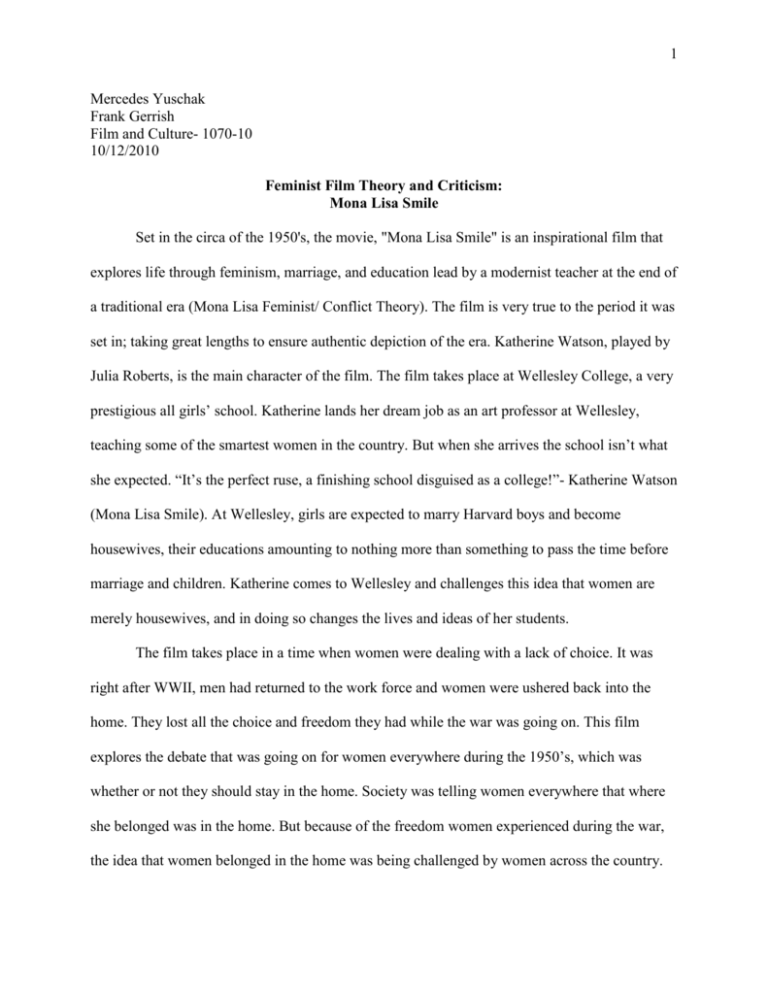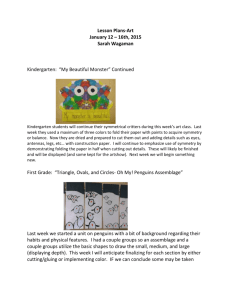Feminist film theory and criticism- Mona Lisa Smile
advertisement

1 Mercedes Yuschak Frank Gerrish Film and Culture- 1070-10 10/12/2010 Feminist Film Theory and Criticism: Mona Lisa Smile Set in the circa of the 1950's, the movie, "Mona Lisa Smile" is an inspirational film that explores life through feminism, marriage, and education lead by a modernist teacher at the end of a traditional era (Mona Lisa Feminist/ Conflict Theory). The film is very true to the period it was set in; taking great lengths to ensure authentic depiction of the era. Katherine Watson, played by Julia Roberts, is the main character of the film. The film takes place at Wellesley College, a very prestigious all girls’ school. Katherine lands her dream job as an art professor at Wellesley, teaching some of the smartest women in the country. But when she arrives the school isn’t what she expected. “It’s the perfect ruse, a finishing school disguised as a college!”- Katherine Watson (Mona Lisa Smile). At Wellesley, girls are expected to marry Harvard boys and become housewives, their educations amounting to nothing more than something to pass the time before marriage and children. Katherine comes to Wellesley and challenges this idea that women are merely housewives, and in doing so changes the lives and ideas of her students. The film takes place in a time when women were dealing with a lack of choice. It was right after WWII, men had returned to the work force and women were ushered back into the home. They lost all the choice and freedom they had while the war was going on. This film explores the debate that was going on for women everywhere during the 1950’s, which was whether or not they should stay in the home. Society was telling women everywhere that where she belonged was in the home. But because of the freedom women experienced during the war, the idea that women belonged in the home was being challenged by women across the country. 2-Yuschak “Mona Lisa Smile” shows the debate and challenge women were going through during this time period. All characters face this debate in some way throughout the movie, some choosing to stay in the home, while others question it. Throughout the film, gender is very black and white in a way. Women have certain ideals and images to strive for, or conform to. Women are seen as housewives and home makers. Their education is there to teach them how to be good wives to their husbands. “You all may be here for and easy ‘A’, but the grade that matters the most is the one he gives you,” Nancy (Marcia Gay Harden), the poise and etiquette teacher at Wellesley, tells her students during a lesson. The women of Wellesley are expected to act a certain way, conduct themselves with poise and manners, and not question the roles society has given them. The girls that don’t conform to the role society has given them are looked down on, like Katherine, who challenges everything the girls are taught to believe. The men in the movie are represented as such, as men. They go to school, they get good jobs, and they support their family. They are very manly or masculine. There is no question that they are men, or that they are deviating from the role society has given them. All the men in the movie are either going to school and looking for a wife, or engaged or married. The only man that isn’t looking for a wife or married is the Italian professor, Bill Dunbar. But even though Bill isn’t married or looking for a wife, he is still represented as a masculine man by the fact that he was in the war and in the fact that he has affairs with his students. On the surface gender in the film is very black and white, with women fitting into a certain ideal or image along with men fitting into an ideal or image. But underneath the surface, you see there are more to the characters then the gender roles that the society of the time assigned to men and women. Throughout the film there is this grand assumption that women 3-Yuschak want to be married. “No woman chooses to have a life without a home,” Betty Warren (Kirsten Dunst) Says to Giselle Levy (Maggie Gyllenhaal), talking about Katherine not being, or not wanting to be married. During the time period it was unheard of for a woman not to want to be married. The same didn’t go for men, although it was also expected of men to get married and have a family, they weren’t raised with the idea that they had to be the perfect husband. There was a gender assumption in the 1950’s that women had to get married and become mothers. That was their goal and purpose in life. Many women conformed to society’s ideals simply because everyone else was. This is still true with some women today. Many women become wives and mothers simply to conform to the expectations of the family and society around them and not really because that is what they want (Natarajan). In the scene where Joan (Julia Stiles) tells Betty she applied to Yale, Betty response to the idea that Joan might want to go to law school with disgust saying, “Why?! You don’t want to be a lawyer!” There was no question in Betty’s mind that Joan should want to get married. Betty ends the talk saying, “You are this close to getting everything you wanted; and this close to losing it.” This assumption that women wanted to be married was more than an assumption, but also an expectation of women in the 1950’s. This expectation carried into everything the girls were taught, everything the girls learned. They were taught the right way to cross their legs, the right way to hold a cigarette, what to say at a dinner party, and so on. They were taught to be the perfect housewife. “There was no sense that your education was valuable in its own right, nor that you were going anywhere with your education,” (College Then and Now). Women weren’t expected to have desires outside of being a housewife. In the 50’s girls went from high school to college, to marriage. They were never given the opportunity to work; it wasn’t an option for women. Women’s desires in the film are expected to be to have a home and a family. You see 4-Yuschak the school and family of the girls pushing them toward these desires, not considering they may have other desires. “A few years from now, your sole responsibility will be taking care of your husband and children,” (Mona Lisa Smile). Katherine is the one in this film that really shows the girls that they can have other desires, and helps them, or more likely pushes them in the direction of other desires. Katherine is really the complete opposite of what a Wellesley girl should be. She’s really another extreme in the film. Although she helps the girls to see that there is more than just being a housewife, she also pushes her ideas of what a woman should be. She hates the idea of being a housewife, and she tries to push her students to work, and not become housewives. Through the struggle Katherine has with her students, both with them accepting her, and her accepting them, you see the true wants and desires of the characters. Each girl in the film was different and had different desires. Joan, had the desire to go to law school, but she also had the desire to be a wife and a husband, and ultimately chose to be housewife. Not because she thought she couldn’t be a lawyer, but because she truly wanted to be a housewife. Joan represents the ideal woman of the 50’s with her choice to become a housewife instead of a career woman. Betty has the desire to be a housewife, but she becomes very unhappy once she’s married, seeing that it’s not all she thought it was. Her ideals change quite a bit at the end of the film, she realizes that being married is not making her happy, and she goes against her mother and her mother’s ideals when she gets a divorce. Giselle is the character that refuses to conform to societies ideals. She has affairs with Bill Dunbar and a married man. She comes off as very promiscuous, but underneath you see that she’s in a way just looking for love just like all the other girls. Throughout the film I think that there is this underlying feeling that all the girls are just looking for love. In that way it supports that all the women just want to get married and have families. 5-Yuschak Katherine is a woman who doesn’t want to get married; she portrays an image of independence throughout the film. She is really a strong image of a strong woman in an environment filled with images of the perfect housewife. Betty is one image of a perfect housewife; she is always poised and well mannered. Most of the Wellesley girls are the picture of the perfect housewife, except for Giselle. They are always well kept, their hair is always done, their make-up is always perfect, and their clothes are always nice. They want to put out the best image. The best image gets the best label. “There are a lot of labels here I’ve noticed; right family, right school, right art, right way of thinking,” (Mona Lisa Smile). The image of women in the 50’s was that of the perfect wife and mother. This is evident in the ads and TV shows of that era. “A girdle to set you free,” from one of the ads Katherine shows to the class. The ads Katherine shows in class all picture perfect smiling women. Their hair is done, their make-up is done, and whatever the ad is for, whether for girdles or ironing boards, the woman is always smiling and happy. There isn’t really a male view in this film, but the ads are from a male’s view. Back then women didn’t work, they didn’t make the ads, men did. The image of the perfect woman, the perfect wife, was the male’s view of how a woman should be. In “Mona Lisa Smile” there are a lot of subtle cues that women are second to men. “A good wife lets her husband think that everything is his idea, even when it’s not,” (Mona Lisa Smile). The idea that the man has to have all the ideas is showing that he has dominance over women. In the 1950’s it was very much this way. Men did everything, they went to work, they supported their families, they were in politics, and so on. Women really didn’t have a say how things were done. The idea is that women ran the home. “While our mothers were called to the work force by lady liberty, it is our duty, nigh our obligation to reclaim our place in the home; bearing our children who will carry our traditions into the future,” (Mona Lisa Smile). After 6-Yuschak WWII women were forced back into the home and didn’t have a say about it. They may have wanted to stay in the work force, and keep the freedom they gained, but society, mostly men, didn’t allow it. Society was under the idea that women belonged to men in a way. Bill Dunbar says to Katherine when talking about her boyfriend, “If you were mine, I wouldn’t have let you go.” Saying he wouldn’t have let her go, is really saying that would’ve had no choice in the matter. It was like this for a lot of women. There is the same thing when Katherine is talking to Tommy, Joan’s fiancé. They’re talking about Joan being excepted to Yale and Tommy says just to have it that will be great for her, and says Joan won’t be going to Yale because she’ll be in Philadelphia with him. “That’s a long commute to get dinner on the table by 5.” He already expects her to put her dreams aside for his. Betty is also expected to put aside her happiness for the sake of appearance when her husband is cheating on her. Her mother tells her that not to air her dirty laundry in public. The women in the film go through a lot, and deal with issues coming from the debate of whether or not to stay in the home. You see these issues unfold through the point of views of the female characters. Because the main characters are women the whole film is through the point of view of women. You see the concerns they have, concerns about marriage, sex, love, and school. These concerns influence them to get married, find love, and to fulfill their dreams and desires. These concerns also in some cases, like with Betty, force them down a path of unhappiness. In everything they do, the idea that they should stay in the home and raise a family affects them. They either conform to what society expects, or they don’t and get looked down on by others. Even though the film is threw the point of view of women, and main idea that affects all the characters I think is the view of a man. It was expected by men in the 50’s that their wife stay in 7-Yuschak the home. “Mona Lisa Smile” is a great look into the past, at how women thought and what was thought and expected of them. “She’s smiling, is she happy?” (Mona Lisa Smile). The Director did a very good job in keeping with the feel of the 50’s. Everything from the costumes to the sound and lighting help to make you feel like it’s the 50’s. One of the most memorable scenes from the movie is Katherine’s first day of class. The shots and sound help to make you feel just as uncomfortable as she does. I like the reaction shots of Katherine while hearing the students name the art. Another scene that has a memorable element of form is the scene right after her first class when she’s having a meeting with the school board. She’s sitting at the far end of the table and everything is set so she looks very lonely and small. The table is very empty and long, and there is nothing behind her but a dark paneled wall. Another element of form that stands out is the colors. There are a lot of dark colors, a lot of browns and blues. Another scene that really stands out to me is the scene of Katherine’s second class. The sound of the projector and then silence makes you feel slightly uncomfortable, but it also draws a lot of attention to the painting of the raw carcass. The rustling of the pages of the textbooks really draws your attention to the fact that the students don’t know what the painting is. The director also uses a lot of hard and soft focus in shots. There is also a lot of close ups on objects or unimportant characters. The Other scene that really stands out to me is the scene where Betty is talking to her mother in the library. The lighting is very dark; the music is really soft and a bit sad. The director uses a lot of reaction shots on Betty and her mother to show the sadness of Betty and the uncomfortableness of Betty’s mother. 8-Yuschak College Then and Now, Mona Lisa Smile DVD special features Mona Lisa Smile Feminist/ Conflict Theory. 29 Mar 2006. eCheat. 18 Oct 2010 <http://www.echeat.com/essay.php?t=28626>. Natarajan, Ashok. Feminine Individuality. World Academy of Art & Science. 23 Feb. 2010. Web. 13 Oct. 2010. <http://www.worldacademy.org/forum/feminine-individuality>. Newell, Mike, dir. Mona Lisa Smile. Perf. Julia Roberts and Kirsten Dunst. 2003. Revolution Studios, Columbia Pictures, 2004. DVD-ROM.




